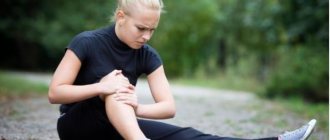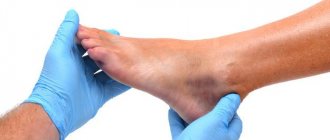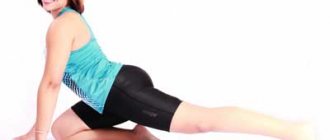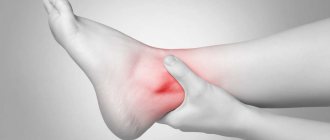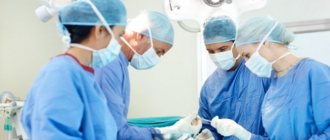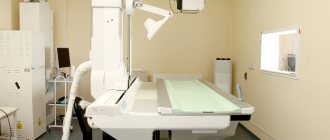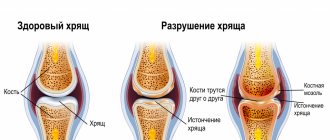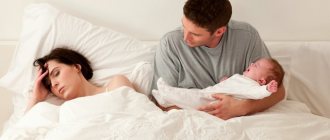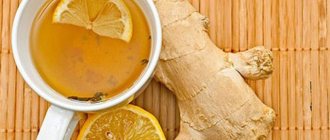During pregnancy, a woman's body is completely rebuilt. The body adapts to bearing a child, creating the most comfortable conditions for him. Often this is to the detriment of the mother's body. The formation of the baby’s inert structures is carried out by leaching calcium from the woman’s body. The reserves of all vitamins and microelements are depleted. The body can no longer provide itself with everything it needs.
Knee pain after childbirth is common during the recovery period. It is impossible to single out one cause of pain. It occurs due to the influence of a whole complex of factors on the body. Treatment is individual and depends on the characteristics of the woman’s body.
Causes of knee pain after childbirth
Knee pain often bothers women both after childbirth and shortly before it. Discomfort occurs when walking, squatting, or simply bending your legs. This is due to a number of reasons, both natural and pathological.
- Changes in posture during pregnancy, weakening of muscles and ligaments. As the fetus grows, the woman’s body weight increases and the load on the musculoskeletal system increases: the entire weight of the body falls on the knees and feet. The muscles and ligaments are relaxed and cannot fully maintain posture. After childbirth, the load decreases sharply: such changes have a detrimental effect on the joints, they begin to hurt. In addition, during pregnancy, the hormone relaxin is produced, which causes softening of ligamentous tissues, including in the knee joint.
- Traumatic situations after childbirth, while caring for a newborn. After a young mother is discharged from the maternity hospital, the load on weakened and overloaded muscles and ligaments is resumed, because the woman has to hold the baby in her arms for a long time (especially if she does not have assistants), and often feed him in an uncomfortable position. In addition, you can get additional injury to your knees when turning a heavy stroller, when the body turns around, but the feet remain in place. Excess weight that does not go away quickly also aggravates the problem.
- Complications from anesthesia during childbirth, injuries. Of course, this occurs quite rarely, most often if a woman was predisposed to joint diseases before pregnancy. Anesthesia (especially if done incorrectly) is a provoking factor, in isolated cases causing nerve damage and even paralysis of the lower extremities. In addition, during labor, sudden movements are often made, which can cause involuntary dislocation of the knee joint. On the other hand, at this time it is possible for fluid to accumulate in the joint capsules, which later manifests itself as pain.
- Lack of calcium. During pregnancy, the body's need for this mineral increases: if the resulting deficiency is not compensated, the macroelement is washed out of the teeth and bones. At the same time, the woman develops caries, her gait changes, there is a crunch when walking, hair falls out, nails peel, and pain in the knees also occurs. To identify this factor (which can lead to osteoporosis, a serious bone disease), the doctor prescribes a special blood test for the pregnant woman.
- Swelling of the joints. During the process of bearing a child, due to the influence of hormones, many women suffer from edema. Moreover, if a joint, including the knee, swells, the surrounding nerves are compressed, and as a result, pain occurs (this phenomenon is also called tunnel syndrome). After childbirth, this condition quickly normalizes. However, if the mother has kidney pathologies, the process may worsen.
- Hereditary factor. If a woman has a genetic predisposition to joint diseases (for example, rheumatoid arthritis), then childbirth (and this is a stressful situation) can serve as an impetus for their development.
Causes of pain
Pain after childbirth that appears in the joints may be associated with the recovery processes of the female body. It may indicate the development of some complications. The most common causes of joint pain are related to the body's reaction to stress such as childbirth. This may also be a consequence of disorders occurring with the musculoskeletal system, which arise against the background of a deficiency of essential microelements.
Unpleasant and painful sensations in the joints often indicate a decrease in the strength of bone or connective tissue. This condition can be caused by a lack of calcium and magnesium in the body. And sometimes this can be a complication after the use of an anesthetic drug during childbirth. Especially if the woman in labor has contraindications to pain medication.
Inactivity during pregnancy causes subsequent knee pain
Knee joints hurt due to weakening of the muscular and bone apparatus, which is associated with passive physical activity during gestation. A discomforting symptom that manifests itself in the area of the pelvic bones is usually associated with difficulty moving the baby through the birth canal. In this case, the risk of dislocation increases.
After the birth of a child, a woman’s body begins to get used to a completely different load. Weight becomes less, and activity increases. With pathological processes that began to develop during pregnancy and were not detected, then the back or lower back may hurt severely. This may be due to a curvature or herniation of the spine.
Sometimes excessive accumulation of fluid in the female body can lead to discomfort in the joints. But all the unpleasant sensations associated with this gradually disappear when breastfeeding ends. Pain syndromes in the shoulder girdle and hands may be associated with the need to frequently carry the baby in your arms.
Often, failure to follow medical recommendations can lead to joint pain. After the birth of the baby, the new mother should give up active training and increased physical activity. The body needs to be given the opportunity to rest from the stress it has experienced. Otherwise, joint problems cannot be avoided.
During childbirth, women stretch the muscle tissues of the spine, pelvis and ligaments of the pubic joint. Because of this, noticeable lumbar pain then appears, which gradually moves to the lower extremities, affecting the feet. Discomfort in the legs may be associated with varicose veins. Typically, the prerequisites for such a disease begin to emerge during pregnancy.
IMPORTANT! The root cause of the pathology itself can sometimes be determined by the location of the pain. The hip joint can cause discomfort due to the separation of the pelvic bones. This occurs when the baby's birth canal is obstructed. In this case, the joints recover spontaneously within two weeks.
Pain in the area of the wrist joints, hands and fingers appears quite rarely. Such discomfort may be due to the fact that during childbirth a woman persistently grabs and squeezes a sheet or other nearby objects. When the baby is born, the mother constantly rocks and carries him in her arms. As a result, the cartilage tissue of the fingers and hands, which has not had time to recover, begins to become inflamed, causing even more injury.
The skeletal system of the legs is affected due to the fact that the female body faces a colossal load. As the fetus develops and the baby's weight increases, the knee and ankle joints begin to suffer from excess body weight. After childbirth, the load decreases, but the woman spends a lot of time on her feet. This causes pain that occurs when squatting, walking, and even while lying down.
Typically, such a symptom, not associated with internal pathological processes, goes away on its own a month after birth. Sometimes the full recovery process takes a little longer. But if the unpleasant painful sensations do not go away and the woman feels severe discomfort every time she bends, she should seek help from a specialist.
How to get rid of knee pain
Knee pain in the postpartum period can be a consequence of natural processes occurring in the body. In this case, the woman should not worry: the discomfort will gradually disappear within one or several months. However, some measures will help speed up this process.
Massage
A massage will ease the condition of a young mother: it will normalize blood flow in the lower extremities and reduce pain. You can do it at home, although, of course, the ideal option is to contact a professional.
When performing manipulations, a woman should use foot creams or special massage oils (if breastfeeding, you should choose hypoallergenic options). For best effect, they are preheated.
During knee joint massage, stroking, rubbing and kneading techniques are used. Each action is repeated three to six times.
- Sitting on the bed, the woman straightens one leg (it is massaged first), and lowers the other. One hand is placed just above the sore knee, and the other below. Then the problem area is stroked in opposite directions. After this, the actions are repeated on the other leg.
- The next technique is rubbing the lateral surfaces of the knee with forward and backward movements. This is done first with the fingers and then with the palms.
- Next, rubbing the side zones is done with the thumbs using circular movements.
- All areas of the knee are kneaded with deep but gentle pressure from the fingers (index, middle and ring), while the skin moves forward and backward.
- The massage ends with gentle stroking of the knees.
This procedure should be done, if possible, two to three times a day, its duration will be no more than 10 minutes. If the massage is performed once a day, then it should take about 25 minutes.
If the knee is clearly injured (for example, due to careless actions with a stroller), swelling is pronounced, then massage will be an addition to other therapeutic procedures. In this case, the duration of the course is determined by the doctor, and the manipulations themselves are carried out by a specialist. They will be more delicate. You should start with small loads, which gradually increase. To the standard techniques of stroking and rubbing will be added shaking the leg, vibration and kneading the joint with a rib and fists.
Special exercises
Special exercises help cope with pain. Provided there is a successful birth, you can start doing them a week or two after the baby is born (in the case of a cesarean section, this is done much later - no earlier than two months, and in agreement with the attending physician).
The exercises are aimed mainly at stretching and lengthening the muscles. You can perform them in the morning (even while lying in bed), during the day (while the baby is sleeping) or in the evening (to relax before bed). The number of repetitions is 5–7 times.
- Why joints hurt after childbirth: main causes, symptoms and treatment
- Bridge. The purpose of the exercise is to strengthen the hips to reduce tension in the knee joints. The woman lies on her back, her arms are located along her body. Your knees should be bent and your feet should be shoulder-width apart (with your toes straight). With a slow movement, the pelvis is raised from the floor, fixed in this position for a few seconds, and then lowered.
- Raising your legs from a side lying position. The woman extends her lower arm, puts her ear to her shoulder, bends slightly at the waist and brings her folded legs forward a couple of centimeters. Next, the upper leg needs to be raised as high as possible, without bending the body forward or backward. After 5–7 repetitions, you should change the upper leg. If it is difficult for mother to maintain balance, then when performing the exercise, she is allowed to lean her back against the wall.
- Squats with a fitball - a large gymnastic ball. This uses not only the leg muscles, but also the buttocks (which makes them more elastic). The ball is leaned against the wall using the lower back. The feet are shoulder-width apart and the toes are pointing straight forward. Pressing the projectile against the wall, the woman slowly squats down. To avoid pain in the knees, movements should be very careful and smooth.
Taking medications
If knee pain is caused by a lack of calcium in the body (this is confirmed by a blood test), then the doctor prescribes the appropriate medications to the mother: Calcium D3 Nycomed, Pantovegir, Kalcemin and others.
In some cases, knee pain can be relieved by taking calcium supplements.
To reduce pain, many women agree to take painkillers. However, if a mother is breastfeeding, then most of these medications are contraindicated for her. In this case, only the doctor selects analgesics, anti-inflammatory drugs or chondoprotectors (agents for nutrition and regeneration of cartilage tissue), allowed during lactation. There are also special patches that have a local effect on the affected joint.
Diet for knee pain
To speed up the recovery of the knee joint, the body must be provided with all the necessary nutrients. A balanced diet will help with this. Thus, calcium can be obtained from dairy products, as well as vegetables (cabbage, parsley and dill, green onions, legumes) and some fruits (persimmons, grapes, oranges), berries (currants, strawberries, gooseberries). In addition, the formation of cartilage and bone tissue is promoted by vitamins E, C and B, which are also found in large quantities in certain foods (for example, there is a lot of vitamin E in vegetable oils and egg yolk). Omega-3 fatty acids also benefit joints, and nuts, seafood, and lentils are rich in them.
Folk recipes
Traditional medicine offers its own ways to combat knee pain: warm foot baths (with immersion of the kneecap). For this, herbal infusions of chamomile, lemon balm, and lavender are used, which have anti-inflammatory properties, promote relaxation and relieve muscle tension.
As an option, you can try alcohol processes. Gauze is soaked in tincture of propolis, horseradish or comfrey root and applied to the joints. For the best effect, the problem area should be wrapped in cellophane and wrapped in a towel. The duration of the procedure is at least half an hour.
Before using an alcohol compress, you should consult a specialist. Alcohol is absorbed through the skin into the blood and passes into breast milk, so some doctors consider this method of treatment unsafe.
Compresses with medicinal herbs or alcohol will help cope with knee pain.
Organization of daily routine and rest
In order for a woman’s joints to recover faster after childbirth, she needs to rest more, because it’s not without reason that pain often makes itself felt in the evening after a busy day full of worries. The husband and other close people should, if possible, take on household responsibilities.
If all the above measures do not bring relief to the mother, then she needs to undergo a thorough medical examination. Perhaps knee pain is associated with more serious pathologies (for example, kidney disease). The sooner full treatment is started, the sooner the woman will return to a full life.
Preventing knee pain
Prevention of knee pain should begin during pregnancy. This involves leading an active lifestyle (not gaining excess weight, walking in the fresh air more often, swimming, etc.), doing a special set of exercises every day, and taking calcium-containing medications. If a woman already has diseases of the musculoskeletal system, then she should carefully follow all the instructions of the attending physician.
- Why do you dream about knees?
After giving birth, a young mother must constantly monitor her posture, which will help relieve stress on her knee joints. This is always a straight back, slightly laid back shoulders, an unfolded chest, a tense stomach and buttocks, and a chin parallel to the ground. Such measures will not only benefit your health, but will also provide an attractive appearance.
During the postpartum period, you should, if possible, avoid traumatic situations: for example, adjust the handles on the stroller to your height, and wear only comfortable shoes without heels when walking. A young mother should not make sudden movements when lifting the baby or lifting heavy objects - any load with a sharp turn of the knees can lead to injury. It is important to bend your legs smoothly and accurately, while your back remains straight. You also don't need to spend a lot of time on your knees.
Reviews from young mothers who have encountered this problem
Knee pain is often a natural occurrence during the postpartum period. If the mother leads a correct lifestyle, then her condition will gradually return to normal. However, in some cases, such a pathology may be associated with other reasons and requires contacting a specialist. The main thing for a woman is to be attentive to her health, because the baby needs a strong and happy mother. And knowing preventative measures will help you avoid pain in the future.
During pregnancy, a woman's body undergoes significant changes and also experiences extreme stress, especially during childbirth. After the baby is born, such stress can lead to complications, such as pain in the joints of the hands, fingers and feet.
Half of women who have given birth complain that their knees hurt after childbirth, their arms hurt, and it hurts to stand up or squat. Usually the discomfort goes away over time when the body is fully restored, but sometimes it needs help. Why do my knees hurt and how to deal with it?
Eliminating pain
The best way to relieve pain is
impact on the immediate cause of unpleasant sensations. If it is impossible to install it, there are a number of universal tips. Systematic adherence to a set of instructions will help to significantly improve your well-being by reducing pain.
During the postpartum period, the body is exhausted, so it is necessary to take specialized complexes of vitamins and microelements. Particular attention must be paid to calcium, as its levels are significantly reduced. When planning a pregnancy again, it is recommended to take such medications prophylactically, but only after consultation with a specialist.
It is necessary to monitor your posture. Correct placement of the spine will help reduce stress on the lower extremities. A normal postural position is the prevention of muscle deformation in the postpartum period.
You should try to avoid heavy loads and injuries in the period after childbirth.
The components of the musculoskeletal mechanism are restored after systematic stress during pregnancy. Heaviness, significant loads, very sudden movements - all this has an extremely negative effect on the regenerative processes of the body. You need to lift and carry the child smoothly, while keeping your back straight. Maximum tension should be placed on the muscles of the buttocks and upper abs, and not the spine.
It is recommended to avoid rotation (circular movements) in the knee joint. A small load combined with a sharp rotation of the joint can cause dislocation or muscle strain.
Physical activity should be minimal. If your knees hurt after a hard day at work, it's most likely due to increased stress on your legs. In such situations, it would be advisable to reduce stress (including unnecessary physical activity) during the period of recovery of the body after childbirth.
To strengthen the muscular system, it is necessary to systematically perform specialized exercises. From the second week of the postpartum period (if a cesarean section was not performed and there were no complications in the anamnesis), you can gradually begin to exercise. There are stretching exercises for the muscles of the lower extremities, the use of which will help strengthen the tissue structure and relieve muscle spasms.
How does childbirth affect joints?
The nature of pain is not difficult to understand if you understand the impact on the body of the process of bearing a baby and the birth itself. In most cases, unpleasant sensations are of a physiological nature and disappear within 1–2 months.
While in the womb, the fetus is completely dependent on it. He receives all the necessary nutrients, vitamins and microelements from his mother. If a pregnant woman’s diet does not have enough calcium, magnesium or potassium, the baby will not have enough nutrients.
However, the baby will still get what it needs - from the mother’s bones and joints. As a result, the bones will become more fragile. This is why it is so important to eat well and take the vitamins prescribed by the gynecologist. Otherwise, the woman will feel that her hip joint hurts, her knees hurt when bending, and so on.
The second factor is excess weight. In 9 months, a woman gains at least 9–12 kg, or even 20–30 kg. Bones and joints experience additional stress, which results in pain after delivery.
- Knees, joints of the arms and legs hurt after childbirth: causes of pain when standing up, squatting and bending
Pain in the legs and back can be explained by a shift in the center of gravity, which occurs in all pregnant women. Sometimes such sensations are associated with injuries to the musculoskeletal system during childbirth.
PRP therapy
This technique is used by leading orthopedists in France, Italy, Israel and other countries. And all because PRP therapy is simple and very effective. It allows the body to recover using its own strength.
PRP translates to “platelet-rich plasma.” Platelets ensure tissue renewal and stimulate the division of stem cells, which accelerates the regenerative (restorative) process of affected tissues.
Platelet-rich plasma is injected into the affected area. To do this, blood is taken from the patient, placed in a special tube and sent to a centrifuge. There the blood is divided into several layers. Thanks to a special tube, exactly the layer where the plasma with the maximum platelet content is concentrated (PRP layer) is extracted.
To improve the accuracy of plasma water, an ultrasound machine is sometimes used.
PRP therapy is absolutely safe, has no contraindications and eliminates the risk of allergic reactions.
Do not confuse PRP therapy with plasma lifting.
Why does it hurt to bend your arms and legs, why is it difficult to squat and stand up?
Often after childbirth, women experience hip pain. Discomfort may appear earlier - in the third trimester. In later stages, the body produces the hormone relaxin, which relaxes the hip joint. This prepares the body for upcoming childbearing by making it easier for the baby to pass through the hip bones.
After giving birth, my mother sometimes has pain in her arm joints. During contractions and pushing, women grab the bed, handrails, and strain their muscles, which creates significant stress on the joints. After this it hurts even to straighten your fingers.
The second reason for heaviness and pain in the hands is everyday chores. The mother of a newborn often has to carry the baby in her arms, which causes fatigue and pain when bending her fingers.
The consequences of epidural anesthesia can affect a woman’s musculoskeletal system. In some cases, after such anesthesia, pain in the knees and other joints may appear.
During difficult births, sometimes the pelvic bones spread too far apart and the tailbone deviates. In this case, you should contact a traumatologist as soon as possible.
Operating method: Knee arthroscopy
Arthroxopia is used to treat pathologies of the knee joints.
During arthroscopy, the doctor examines the knee joint to make an accurate diagnosis and surgical intervention.
Indications for arthroscopic surgery:
- meniscal damage;
- inflammation of the synovial membrane;
- displacement of the patella;
- articular cartilage defects;
- loose bodies in the knee joint, etc.
The arthroscopic surgery lasts about an hour. And the postoperative period proceeds quickly due to the fact that the operation is minimally invasive. The patient recovers on average within 2 weeks (depending on the pathology) and returns to normal life.
Solution
After the birth of a child, most women establish breastfeeding, during which a limited number of medications are allowed. Buying and taking medications on your own is strictly prohibited. The most natural and seemingly safe drugs can negatively affect the health of a newborn. Active and auxiliary components pass into breast milk and may harm the baby.
Usually the problem is solved comprehensively. First you need to undergo an examination to understand the exact cause of the pathology. If there is an urgent need, the doctor will prescribe medications approved during lactation. Therapy is supplemented with diet, therapeutic exercises or massage. A comprehensive approach gives a positive result and a long-lasting therapeutic effect.
Medications
Depending on the nature of the pain, several groups of drugs are prescribed:
- NSAIDs (nonsteroidal anti-inflammatory drugs);
- corticosteroids;
- chondroprotectors;
- vitamins, mineral complexes, biological additives;
- products for external use (gels, ointments, creams).
When the problem is caused by a lack of calcium, magnesium or potassium, the woman is advised to take vitamin complexes (Calcium D3 nikomed, Pantovegir, etc.). The diagnosis must be made after laboratory tests.
Discomfort and pain are effectively eliminated by non-steroidal anti-inflammatory drugs. However, in this case, the therapy will be incompatible with breastfeeding.
Ointments for external use are relatively safe and are not absorbed into the general bloodstream. It should be understood that these remedies alone will not give a noticeable effect.
Diet and drinking regime
A proper diet can pursue 2 goals - reducing excess weight and replenishing missing vitamins and microelements. When losing weight, your diet should be balanced. Mom should not lose nutrients, especially when breastfeeding (the baby should receive all vitamins, proteins, fats and carbohydrates).
Prohibited products:
- baked goods, sweets;
- canned or pickled foods, semi-finished products;
- sausages, sausages;
- carbonated drinks;
- too salty or spicy food;
- fried foods (foods need to be cooked by boiling, stewing or baking).
Allowed (useful) products:
- dairy and fermented milk products (natural, without preservatives, flavors, stabilizers, with a short shelf life);
- vegetables, fruits, berries;
- lean meat and fish;
- fatty fish rich in omega-3 polyunsaturated fatty acids;
- porridge;
- nuts and dried fruits;
- vegetable oils.
It is necessary to drink clean water (tea, coffee or compotes do not count) in sufficient quantities. Water is essential for the normal functioning of the body and helps you lose weight. Proper drinking regimen will relieve swelling, which can also cause pain in the knees or arms.
Joint exercises and massage
Physical therapy exercises are selected depending on the location of pain. When a woman has severe knee pain after childbirth, she needs to alternately raise her legs bent at the knee joint and stay in this position. Over time, increase the number of repetitions.
For pain in the pelvic bones, you need to work out the hip joints. Gradually, squatting and standing up will not cause discomfort. It is useful to do health-improving exercises for all muscle groups. This will strengthen the body and improve your figure.
Therapeutic massage must be prescribed by a doctor and performed by a specialist. Otherwise, there is a risk of getting the opposite effect.
ethnoscience
Joint problems worry many, and traditional medicine has in its arsenal many means of combating them. Among them there are those that are suitable for nursing mothers. You can use the following recipes:
- Infusion of bay leaf. It removes excess salts. Pour 500 ml of boiling water over 25–30 leaves and keep on low heat for 15–20 minutes. Leave for a couple of hours and then drink several times throughout the day.
- Jellied meat and chicken cartilage. They contain a lot of collagen, which is necessary for joints.
- Warm baths for feet and knees. A decoction of chamomile, lemon balm, and lavender is suitable.
- Alcohol tinctures for compresses from propolis or horseradish. Soak gauze in the tincture, apply to the sore spot and wrap with cling film.
Causes of joint pain
During pregnancy, the belly grew gradually, along with the baby. Posture and load on the musculoskeletal system gradually changed. After having a baby, your body changes overnight. In addition, the ligaments are still relaxed, under the influence of hormones, the pelvic bones have separated, clearing the way for the baby. As a result, a woman’s posture undergoes significant changes, and the load on her knees increases.
Everything would be fine, however, few mothers can boast of being in good physical shape.
mainly on one hand, and feeding in uncomfortable positions adds additional fuel to the fire.
Negative changes in posture entail a cascade of problems. Some muscles are overloaded, some are in spasm, some are weakened.
Neighboring muscles try to compensate for the excessive load, perform work unusual for them and also begin to hurt...
Why do my knees hurt during pregnancy?
Pain in the knee joint can occur both during pregnancy and after childbirth. The main causes of pain during pregnancy, on which the doctor bases his decision on how to treat the knees:
- A pregnant woman constantly gains weight. Posture changes, and the load on the leg joints increases almost daily.
- During pregnancy, a woman begins to be especially sensitive to her body and tries to take care of it. Because of this, activity often decreases, which has a bad effect on the condition of muscles and ligaments.
- The hormone relaxin is produced. It causes relaxation of the ligaments, and its excess causes pain in the knees.
- Calcium goes into the formation of fetal bone tissue. In women, this is manifested by deterioration of the condition of the teeth and unpleasant sensations in the joints.
Some of these reasons can be avoided by preparing the body in advance for bearing a child. For example, those who regularly exercised before pregnancy, as a rule, do not stop exercising during pregnancy. They just adjust the set of exercises and the level of load. Prepared muscles suffer much less from changes in load distribution.
Important! During pregnancy, it is necessary to perform at least a minimum set of gymnastic exercises, selected by the instructor taking into account the woman’s condition.
Adequate nutrition in sufficient quantities will provide the woman’s body with calcium and other microelements, which has a very beneficial effect on joint tissue.
The effect of pregnancy on joints
During pregnancy, changes begin to occur in the female body that affect bone and joint tissue. This is considered normal. But if during such a period the diet becomes unbalanced, a significant loss of calcium and many nutrients occurs. All of them are aimed at the formation of bone and connective tissue of the baby, but the expectant mother is faced with the development of pathological processes in her bone structures.
The deficiency of essential microelements that occurs over nine months leads to metabolic processes in the joints being disrupted. Uncomfortable sensations begin to appear. At the same time, an increased load is placed on the entire musculoskeletal system. Body weight is constantly increasing, because of this the joints of the lower extremities, as well as the vertebral column, suffer.
It is also necessary to take into account the fact that during the period of waiting for a child, the production of a hormone called relaxin is activated in the body. Its task is to facilitate labor by relaxing the ligamentous apparatus. Therefore, those ligaments that should support the joints under increased load are in a relaxed state during gestation. This explains why the hands, knees and other joints hurt.
Many joint diseases do not manifest themselves in any way during pregnancy. But after childbirth they begin to worsen. Sometimes a woman may not be aware of the presence of such disorders occurring in her body. She may encounter the following ailments that cause joint pain after childbirth:
- rheumatoid arthritis;
- reactive and psoriatic arthritis;
- ankylosing spondylitis;
- infectious arthritis.
The course of rheumatoid arthritis during nine months of pregnancy is completely invisible. This disease begins to manifest itself after the birth of the baby. As a result, the joints hurt very much, causing the woman significant discomfort.
ATTENTION! Reactive arthritis begins to develop when expecting a child. This is facilitated by infectious processes occurring inside the body. At first, this disease is in a passive stage, and after the birth of the baby it sharply worsens.
If a woman has already experienced psoriatic arthritis before pregnancy, then subsequently, due to hormonal changes in the body, its symptoms may appear immediately after childbirth. Ankylosing spondylitis often occurs during pregnancy. At some point your back just starts to hurt. If a woman mistakes such a symptom simply for temporary fatigue resulting from increased workload, then after childbirth the disease develops with renewed vigor.
As a result, pain begins to be felt in the hip and lumbar joints. In this case, the shoulder joint, lower jaw, and hands may hurt. Therefore, it is important to pay attention to such symptoms even during the period of bearing a baby, so as not to encounter unpleasant signs of a serious illness later.
While expecting a child, a woman's immune system becomes more weakened and vulnerable. There is a risk of any infection entering the body. The most vulnerable areas are the joints of the arms and legs. This can lead to the formation of infectious arthritis.
Causes of pain in the knee joint after childbirth
It is impossible to give a definite answer to the question, why do my knees hurt after childbirth? There can be many reasons.
Sudden changes in weight and center of gravity during childbirth
During childbirth, a woman's body undergoes significant changes. Weight drops sharply. The center of gravity is shifted. The spine, joints and muscles have to be rebuilt at once, without preparation.
Anesthesia
Spinal and epidural anesthesia in some cases can have side effects such as pain in the knee joint and ankle. The risk is especially high for those who suffered from musculoskeletal diseases before pregnancy.
Edema
During pregnancy, women often experience swelling of the extremities, which disappears in the first days after childbirth. If they persist for a long time, this may indicate kidney or bladder disease. In addition, swelling can put pressure on nerve endings and thereby cause pain.
Increased load
With the birth of a child, the load on all the mother's joints increases sharply. In addition to everyday household chores, there is a need to care for the baby. One of the most dangerous actions for joints is rocking a baby for a long time, standing in one place, or feeding in an uncomfortable position.
Posture
Not all women monitor their posture during the postpartum period; this leads to the fact that the load is distributed unevenly across all parts of the spine and joints. As a result, knee pain occurs.
Child staying in mother's arms for a long time
If the baby is restless and spends a long time in the mother’s arms, then not only the joints of the arms, but also the legs may hurt. Muscles also suffer from overexertion.
Improper lifting of weights
Often mothers do not think about how to properly raise their child. They bend over to the child and immediately pick him up. This method can damage the spine and lead to pain in the joints of the legs and arms. To lift the child correctly, you need to keep your back vertical and bend your knees. Hold the child close to you and then straighten your knees. It is very important to keep your back straight all this time, without tilting your body.
Taping
(literally “fastening with tapes”) - tape will help fix a joint, muscle, ligament or tendon in the desired position. Thereby creating peace in the area where it is fixed.
By lifting the fascia due to the fixed skin, lymphatic drainage of the damaged area increases, blood supply improves, which has a positive effect on the recovery of the damaged area. And when moving, there is an alternating tension and weakening of the skin, etc. The tape is elastic, creating the effect of a light massage. This massage activates muscle metabolism, which allows you to create the best conditions for healing, avoiding complete immobilization.
This method is widely used by sports doctors.
It is very important that the tape is applied by a trained specialist (traumatologist or chiropractor). Because Each case of injury or pathology is individual (the characteristics of the problem and the nature of the injury must be taken into account). And applying a patch is impossible without knowledge of anatomy: the location of muscles, ligaments, places of their attachment, physiological mobility of the limb.
How to cope with postpartum joint pain?
Some factors do not indicate any organic changes. The pain they cause will go away on its own, without the help of medical professionals. However, you should consult your doctor if the pain continues for quite a long period and becomes more severe. In addition, an increase in body temperature will be an alarming signal. This may indicate an exacerbation of joint disease or inflammation. This condition, unfortunately, will not go away on its own.
If the cause of pain in the knee joint is not inflammation, then you can alleviate it by following some simple rules. To get rid of pain in the knee joint, you need to ensure that your body moves correctly in space:
- The condition of not only the spine itself, but also the joints depends on posture.
- All movements should be smooth, this is especially important when lifting a child.
- It is highly undesirable to perform a body rotation if the feet remain in place. Such movements often lead to pain in the knee joint.
It is also important to dose physical activity. With the birth of a child, a woman loses the opportunity to provide herself with complete peace, but the load can be optimized in the following ways:
- Household chores must be shared with other family members. If a young mother’s knees begin to hurt more when performing household chores, then she needs to take a break.
- Two weeks after giving birth, it is useful to start doing light gymnastic exercises to return the muscles to their previous state. Such gymnastics can be performed even while lying down.
- To more evenly distribute the weight of the baby in the mother's arms, it is worth using a sling.
With knee pain, additional symptoms may appear, such as crunching and clicking when walking, and limited movement. With such manifestations, you should not postpone consulting a doctor.
